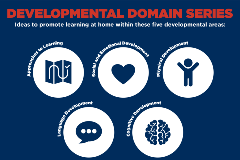- 877.624.2604
- Schedule a Tour
 This month, let’s take a closer look at the Cognitive Development Domain, focusing on social studies.
This month, let’s take a closer look at the Cognitive Development Domain, focusing on social studies.
Cognitive development involves how children think, explore and figure things out. It refers to things such as memory and the ability to learn new information. This domain includes the development of knowledge and skills in math, science, social studies, and creative arts.
Preschool, which includes infants through Pre-K, gives children their first sense of community outside the home. Social studies begins as children make friends and participate in decision-making in the classroom. Then, it moves beyond the school into the neighborhood and around the world. As children get older, social studies deepen to include history, geography, economics, and ecology.
You can encourage social studies learning at home.
Infants:
- Use titles to explain family relationships to your child. For example, when visiting your child’s grandparents, gesture to their grandfather and say “grandpa.” In addition, point out these family relationships when looking at photos of family and extended family.
- Read books with your infants that portray diverse family structures, races, and abilities. Point out relationships while reading.
- Show your child, through your actions and words, how to be kind and polite while interacting with other people.
Toddlers/Twos:
- Read books with your child that portray diverse family structures, races, abilities, and community workers. Point out relationships while reading.
- Talk to your child about your schedule for the day. Use words such as morning, day, afternoon, night, and today.
- Give your child choices throughout the day, for example when deciding what to eat or what activities to do. This will help them develop as decision makers.
Preschool/Pre-K:
- Draw a picture of your yard or neighborhood with your child. Talk to your child about the different features such as trees, lakes, hills, or mountains. Use the drawing as a map that you follow with your child.
- If your child has a problem, encourage them to try to solve it on their own before you help.
- Talk to your child about their friends. Ask them to talk to you about how their friends are the same as they are and how they are different from them. Point out ways in which other people are similar and different.
School Age:
- Ask your child about their day. Ask questions that encourage them to talk about their schedule and the sequence of their day.
- If your child asks for something and your answer is no, rather than simply saying “no,” discuss your decision. Encourage them to think about the reasoning behind your decision.
- Have your child help you to sort your recycling from your trash. Talk to your child about recycling and discuss why it is important.
Here are some great resources about how to support social studies learning at home:
https://www.naeyc.org/our-work/families/what-do-children-learn-preschool-program
https://www.naeyc.org/resources/pubs/yc/nov2018/learning-about-nature-cities
https://www.naeyc.org/resources/pubs/tyc/apr2019/preschool-in-the-park
Miss the most recent article in our series? Read it here.
